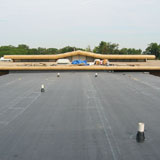During the past several years, fundamental changes in the model code organizations in the United States have resulted in numerous changes in code adoptions and applicability in state and local code jurisdictions. The changes most likely will affect many roofing contractors; following is a brief discussion of some of these changes.
IBC
In March 2003, the three "legacy" model building code organizations in the United States—Building Officials and Code Administrators International (BOCA) Inc., International Conference of Building Officials (ICBO) and Southern Building Code Congress International (SBCCI) Inc.—consolidated into the International Code Council (ICC). ICC publishes the International Building Code (IBC), International Residential Code (IRC) and a number of other related codes. (Additional information can be found in "Consolidation of code organizations," January 2003 issue, page 57.)
As a result of the consolidation, the model building codes previously published by BOCA, ICBO and SBCCI no longer are being updated. Consequently, many jurisdictions that previously had adopted BOCA's, ICBO's or SBCCI's model building codes now have adopted IBC.
IBC also has been adopted by a number of jurisdictions that previously had developed their own codes. For example, New York state and Wisconsin now use IBC. Both previously had maintained their own state-developed building codes since the early 1900s.
Currently, 44 states and more than 400 local jurisdictions use IBC's 2000 and 2003 editions. IBC adoption by additional jurisdictions is anticipated.
As part of the legacy code organizations' consolidation into ICC, ICC Evaluation Service (ICC-ES) Inc., a subsidiary of ICC, also was established. ICC-ES takes the place of the legacy code organizations' evaluation service groups (BOCA Evaluation Services Inc., ICBO Evaluation Service Inc., and SBCCI Public Safety Testing and Evaluation Services Inc.) and National Evaluation Service Inc. ICC-ES provides technical evaluations, referred to as evaluation reports, of building products, components, methods and materials for the purpose of determining IBC compliance.
Until March 1, ICC-ES will continue to reissue legacy evaluation reports bearing the name of the originating legacy evaluation service group. After March 1, any reissued or new evaluation reports will bear ICC-ES' name. Any existing legacy evaluation reports apply until their listed expiration date, which typically is one year or two years after issuance.
NFPA 5000
In 2003, the National Fire Protection Association (NFPA) published its first model building code, NFPA 5000, Building and Safety Code (NFPA 5000). (For additional information, see "NFPA 5000: a new model building code," February 2003, page 36.)
NFPA 5000 currently is in effect in Pasadena, Texas, and is in the process of being adopted by a number of other jurisdictions. For example, Phoenix is in the final stages of an NFPA adoption plan with an effective date anticipated in the next several months. Similarly, the California Building Commission has approved an action that will update its California Building Standards Code (Title 24, Part 2) to consist of a combination of NFPA 5000, IRC and NFPA's NFPA 1, Uniform Fire Code. A 2006 effective date is targeted in California.
An issue of specific concern regarding the adoption of NFPA 5000 is that NFPA has yet to establish procedures or a separate evaluation service organization for the purpose of determining compliance with NFPA 5000's requirements. Until such procedures are in place, adopting and attempting to enforce NFPA 5000 is impractical.
Closing thoughts
The numerous changes in state and local code jurisdictions' adoption of model building codes during the past several years only exacerbates the already complex issue of building code compliance.
I encourage you to become familiar with the specific building code and code provisions applicable in the area in which you conduct business. In many instances, if you perform work in multiple jurisdictions, different codes—or different editions of the same code—may apply. To assist you in providing code-compliant roof systems, NRCA has updated its building codes reference manual. The NRCA Building Codes Manual, Second Edition, includes detailed information regarding compliance with the current editions of IBC, IRC and NFPA 5000; the last editions of the legacy model codes; and up-to-date information regarding code applicability in states and major cities. The manual is available by contacting NRCA InfoExpress at (866) ASK-NRCA (275-6722) or accessing shop.nrca.net.
Mark S. Graham is NRCA's associate executive director of technical services.


